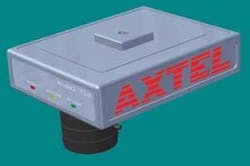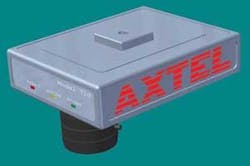Barcode-recognition software gets embedded
By Andrew Wilson
Reading two-dimensional (2-D) codes on parts is an emerging application area for machine-vision systems, particularly those based on smart cameras. To read this code, manufacturers such as Acuity CiMatrix (Nashua, NH, USA; www.rvsi.net), Cognex (Natick, MA, USA; www.cognex.com), and Microscan (Renton, WA, USA; www.microscan.com) have developed hand-held and fixed-mount readers that are used in quality-control and inspection systems to read and verify 1- and 2-D barcodes such as Data Matrix (see Vision Systems Design, September 2004, p. D3).
Recognizing the market potential of these products, Axtel Applied Technology (Vista, CA, USA; www.axtel.com) has announced that it will offer smart cameras specifically for 2-D barcode recognition. Already, according to Peter Knoll, president, the company has licensed barcode-recognition software to OEMs building document scanners, vision systems, digital cameras, and pen-based products. These include a structured-light-based reader from Sagem (Paris; France; www.sagem.com), which is used by the French lottery agency; a document-management system developed by Consolidated National Freightways (Palo Alto, CA, USA; www.cnf.com); and a portable scanning pen translator from WizCom Technologies (Acton, MA, USA; www.wizcomtech.com).
Software-development kits
Axtel’s software-development kit supports both linear and 2-D barcode symbol types and can be integrated into both document scanners and smart cameras, which may view a rotated object in various angles of tilt. When necessary, the software can compensate for unequal illumination within an image. “Because the barcode-recognition software reads color, gray-scale, and monochrome B/W images,” says Knoll, it is not necessary to convert or preprocess images. Available as a 16- or 32-bit DLL and OCX, the AX-4 barcode-recognition engine can be called from Visual Basic or Visual C++ and can be embedded into stand-alone Windows applications.
Axtel Applied Technology is introducing two smart cameras targeted at the machine-vision market. Offering 640 × 480- and 1280 × 1024-pixel resolution, the cameras use an embedded 32-bit fixed-point DSP to perform image processing.
For system integrators who require that this functionality be embedded into a smart camera, Axtel plans to introduce its Model 730 smart camera. Besides being deployed in barcode-reading applications, the smart camera will be used in repetitive-quality-control and inspection systems. Two versions of the smart camera will be offered, both of which use color CMOS imagers from Omnivision (Sunnyvale, CA, USA; www.ovt.com). The first, a 640 × 480-pixel-based camera, will feature an on-board TMS320C64x fixed-point DSP from Texas Instruments (Dallas, TX, USA; www.ti.com), 64 Mbytes on-board memory, 8 Mbytes flash, integrated C-mount lens and LED illuminator, and Ethernet, RS-232, and digital I/O capability. A higher 1280 × 1024-pixel XVGA version of the camera also will be available.
Initially, Axtel will offer both versions of the camera bundled with the company’s barcode-recognition software. “This will provide system developers with an easy way to perform direct-part-marking inspection of PDF 417, QR code, linear, and Data Matrix codes at up to 3000 parts/minute,” says Knoll. With an integrated C-mount lens, the cameras can also be configured for specialized applications that may require macro or telephoto capability. “For applications requiring external illumination sources,” says Knoll, “Axtel will provide both camera-mounted illuminators and lighting panels.”
With its legacy software experience, Axtel’s cameras will find uses in a number of machine-vision applications that require barcode inspection and verification. As yet, however, the company has not announced any general-purpose machine-vision software support for the cameras. Likely as not, this will include Texas Instruments standard development libraries and compilers, although what higher-level graphical development and image-processing toolkits the company will provide remains to be seen.

